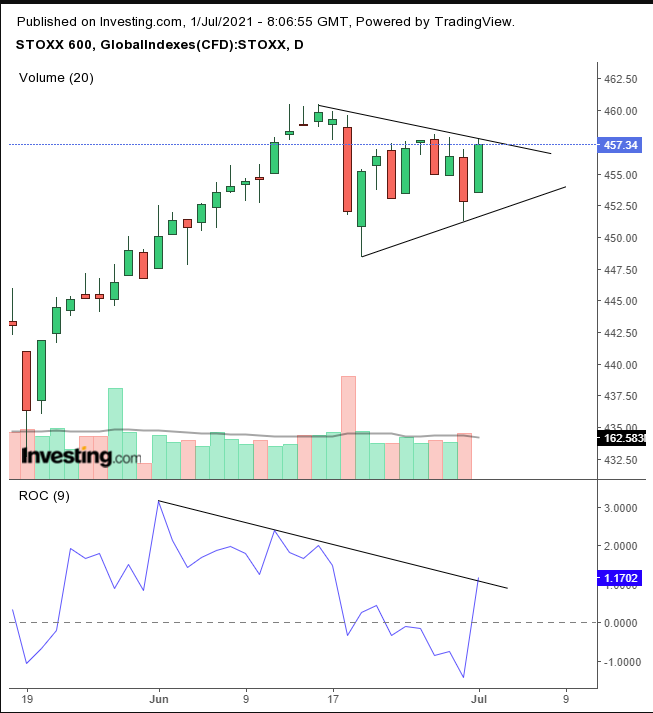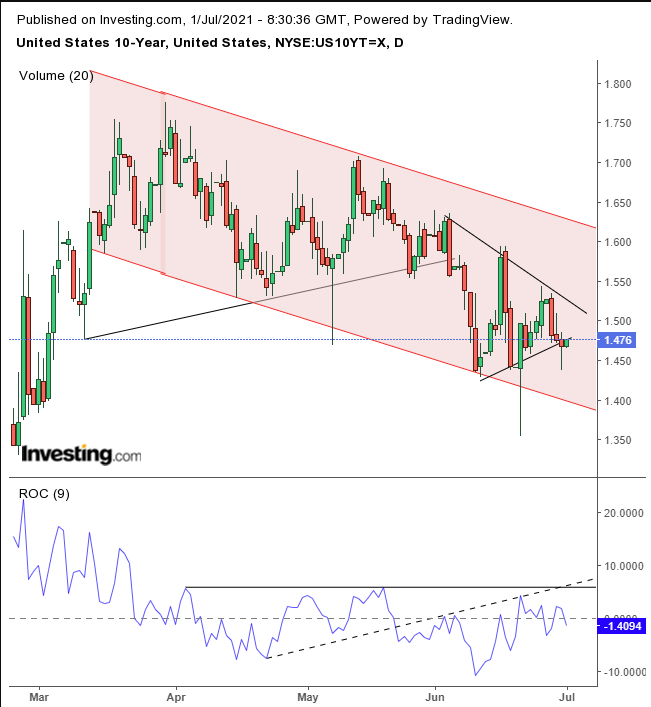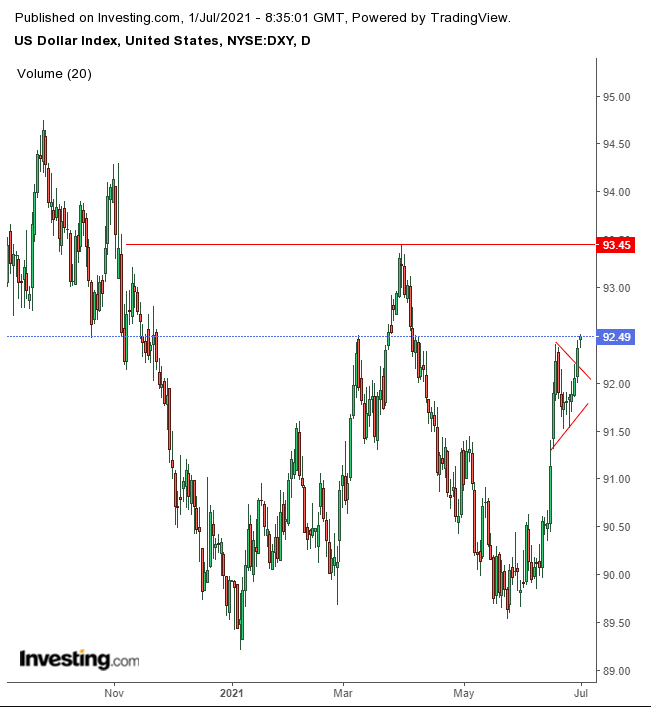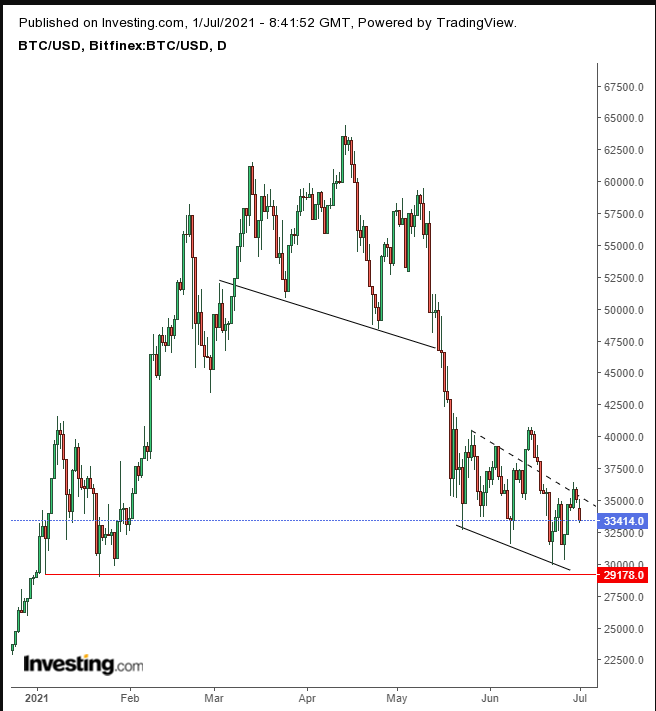- US stocks seal longest quarterly gains since 2017
- Oil reaches highest since 2018
- Bitcoin continues to slide
- ECB President Christine Lagarde is speaking on Friday.
- On Friday, the US releases the nonfarm payrolls report.
- The FTSE 100 Index rose 0.6%
- The STOXX Europe 600 rose 0.8%
- Futures on the S&P 500 rose 0.2%
- Futures on the NASDAQ 100 were little changed
- Futures on the Dow Jones Industrial Average rose 0.2%
- The MSCI Asia Pacific Index fell 0.4%
- The MSCI Emerging Markets Index fell 0.2%
- The Dollar Index was little changed
- The British pound was little changed at $1.3819
- The euro was little changed at $1.1854
- The Japanese yen fell 0.1% to 111.25 per dollar
- The offshore yuan was little changed at 6.4672 per dollar
- The yield on 10-year Treasuries was little changed at 1.47%
- Britain’s 10-year yield advanced two basis points to 0.74%
- Germany’s 10-year yield advanced two basis points to -0.19%
- Brent crude rose 0.4% to $74.93 a barrel
- Spot gold rose 0.4% to $1,776.80 an ounce
Key Events
US futures on the Dow, S&P, NASDAQ and Russell 2000 and European shares advanced in trading on Thursday ahead of Friday’s monthly employment report, a key economic release amid the Federal Reserve's shift on the path towards tighter monetary policy. Asian stocks closed lower on new COVID-19 outbreaks in the region.
The oil price rally continues.
Global Financial Affairs
US contracts climbed ahead of today's weekly initial jobless figures which, along with tomorrow's nonfarm payrolls data generally has some of the strongest impact on markets every month, but which is particularly significant currently given rising inflation and the Fed’s stepped up timeline for higher interest rates is driving markets.
In yesterday’s post we said that growth stocks, including those in the technology sector, were driving markets. However, a snapshot of US futures today shows that the reflation trade is back in vogue.
Value shares such as those listed on the Dow Jones Industrial Average—which outperformed yesterday—compared to the tech-heavy NASDAQ, which was the only major US index to close in the red on Wednesday, and the Russell 2000, whose futures contract is now outperforming those on the NASDAQ 2:1 are driving today's gains.
We are seeing a renewed shift to stocks that were depressed during the coronavirus lockdowns, most notably a rebound in travel shares, after a selloff over the past several days. This is noteworthy as it is incongruous given Europe has started to see outbreaks of the Delta variant and increased concerns about new travel restrictions, battering European travel stocks.
Still, European stocks are trading higher overall, after yesterday’s selloff. The shifting focus is driving a return to optimism of an economic recovery, obscuring yesterday's concerns over the spreading virus and inflation.
On the other hand, most US stocks ticked higher during Wednesday's Wall St. session, with the S&P 500 Index even reaching a new all-time high, posting its best half since 1998. This dichotomy—a rally in the US after a European selloff—contradicts the view of US investment banks that European stocks will outperform the US market this year.
The STOXX 600 Index touched its highest levels since June 17, slightly lower the June 16 record, after yesterday sealing its fifth consecutive quarter of gains—and completing one of the pan-European benchmark’s best first half in over two decades—as German retail sales rebounded in the month of May.

The European gauge has been ranging within a triangular patter, presumed to be a temporary equilibrium before it continues higher. The pattern is complete only upon an upside breakout, preferably amid a spike in volume, demonstrating participation. The sensitive Rate of Change momentum gauge is testing its downtrend line, a leading indicator providing a heads up to the price breakout.
Wednesday was the final day of trading in the first half of 2021 with indices making their best returns, although it was marked by small moves and slow trading. Strong data helped investors endure stretched valuations and the persistent threat of the Delta strain of the coronavirus. The S&P 500 Index is up 14% YTD, locking in its longest winning quarterly streak since 2017.
Yields on the 10-year Treasury note rose, breaking a three-day decline, following yesterday’s imperfect (slight upper shadow) bullish hammer.

Rates are struggling to stay within a triangular pattern. The downside breakout will likely push yields lower, as investors extend a rotation out of Treasuries into stocks, as they gain confidence that the economy and the Fed will prevail over inflation and the pandemic.
The dollar extended a rally to its seventh day,

The greenback is completing a bullish pennant, presumably to propel the US currency to the Mar. 31, 93.45 high, to test a large double bottom.
Gold rose for the second day, together with the dollar. Yesterday’s advance could be attributed to a drop in yields, but today, both the dollar and yields are rising.

The yellow metal found resistance by the bearish pennant, making this an ideal entry for a short position, with the price right beneath the pattern.
Bitcoin fell for the second day, with gold, the dollar and yields on the rise.
The cryptocurrency is extending a potential Head & Shoulders continuation pattern, whose downside breakout would give it the momentum to take on the $29,000 level, the bulls’ last stronghold before $20,000.
Oil advanced toward $75, reaching the highest since 2018, ahead of the OPEC+ meeting, where output will be discussed. Also, the talks between Iran and the US have hit a wall, after a hardliner was elected as President of Iran, removing the expected imminent return of Iranian oil to global markets.

The price is trying again to cut through the $74 resistance, in attempt to reach the highest since 2014.
